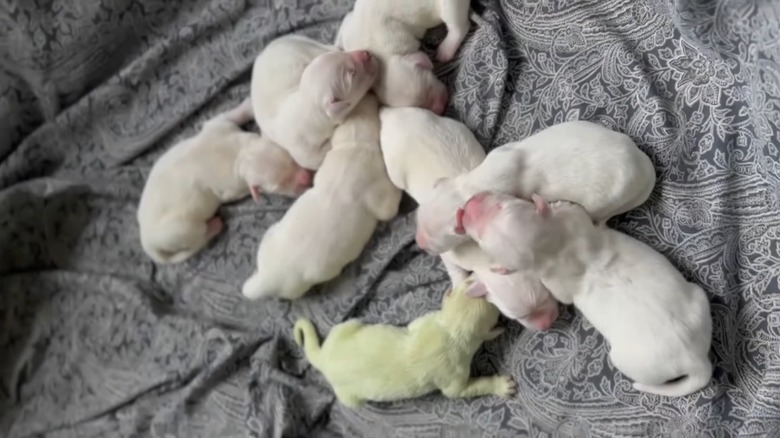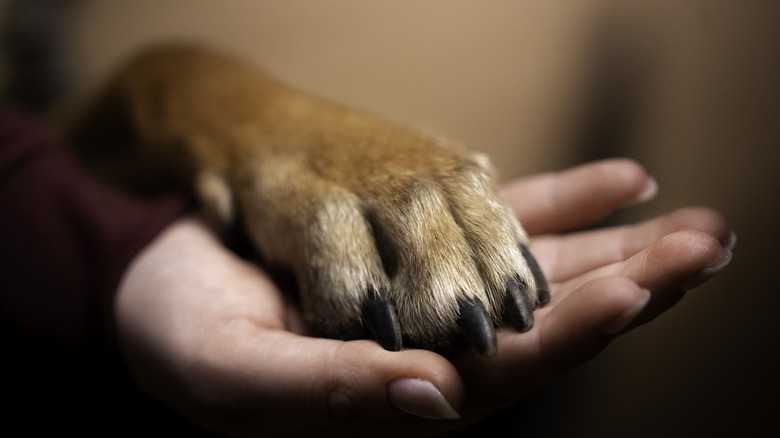Some Puppies Are Born With Green Fur Because Of This Rare Phenomenon
In early 2024, a golden retriever named Shamrock was born with striking lime-green fur in Pensacola, Florida. If you ever find one of your precious newborn puppies sporting a similar sheen of green, rest assured your otherworldly bundle of cuteness is not Hulking out. This rare condition is caused by prenatal exposure to biliverdin, a green pigment found in bile, which is also responsible for the green hue seen in bruises. Biliverdin occasionally affects the fur of light-colored puppies, temporarily staining it green.
While the condition doesn't last, it has captured the attention of people worldwide thanks to the social-media-heavy times we live in powered mainly by random and hilarious photos of dogs and cats. Shamrock's green tint faded within weeks, revealing her golden coat. While rare, similar cases have occurred, such as the 2014 birth of two green puppies from a litter of Spanish hunting dogs and Pistachio, a green puppy born in Sardinia, Italy, in 2020. These cases highlight the surprising ways that biology can sometimes manifest.
The science behind green puppy fur and their health
Biliverdin, a byproduct of hemoglobin breakdown, sometimes stains the fur of puppies in the womb, giving them a temporary green tint. Though biliverdin primarily affects fur color in these rare cases, it is also linked to broader biological processes. In other species, it's responsible for the blue-green color of bird eggs. Beneath their peculiar hue, green puppies often exhibit remarkable resilience and harbor no apparent health complications associated with their unusual coloration.
The green fur does not impact the puppies' genetic coat color, and the tint gradually fades within weeks. Like all puppies, their coats will change color as they grow. While some green pups may appear smaller or weaker than their littermates, veterinarians attribute these characteristics to external factors like maternal nutrition (some newborn puppies may not be getting the milk they need) and genetics rather than the presence of biliverdin.
During the gestation period, maternal nutrition plays a pivotal role in shaping the health and development of puppies. Factors such as the nursing mother dog's dietary choices, nutrient absorption, and overall health can significantly impact the size, strength, and vitality of her offspring. Proper puppy care, such as appropriate nutrition, exercise, and a suitable environment contribute greatly to the overall health and development of puppies, irrespective of their green pigmentation. In fact, most green puppies grow up to be healthy, playful, and energetic dogs who enjoy a normal lifespan.
Research suggests biliverdin could help treat dementia
The pigment that causes green fur in puppies is also involved in important processes in the brain, and scientists have been researching it to understand diseases like Alzheimer's for over a decade now, as seen in a 2012 study published in the Journal of Neurochemistry. This pigment is normally transformed into another substance by a special protein called biliverdin reductase-A (BVR-A). Think of BVR-A as a tiny machine inside the body that converts biliverdin into something else. The study suggest that when this machine doesn't work properly, it can lead to "oxidative stress" –- a kind of damage to brain cells -– and inflammation.
This damage may play a role in the development of neurodegenerative diseases like Alzheimer's, where brain cells gradually die. While this research is still in its early stages, understanding the role of BVR-A could offer new insights into the prevention and treatment of dementia. It's fascinating how the same pigment that causes a puppy's fur to turn green could hold clues to protecting our brains. That's some puppy power, indeed!

